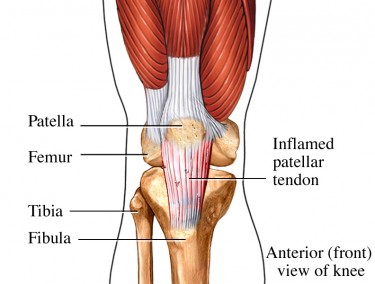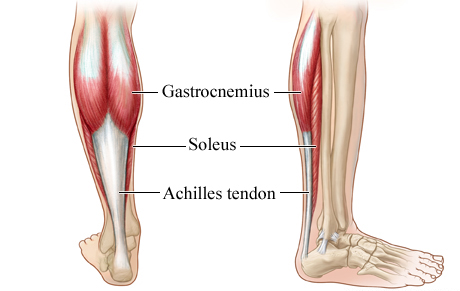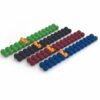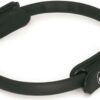A tendon is a thick band which connects a muscle to a bone. Tendinitis is a condition where the tendon becomes weak and inflamed due to overuse which in turns cause pain and discomfort to the affected area.
What causes tendonitis?
- Over use of the tendon usually due to excessive or intense exercise.
- The tendon can become weak due to age or injury.
- In some cases it can be caused by another condition where the joints or bones have already become weakened such as rheumatoid arthritis or Lupus.
What are the symptoms of tendonitis?
Tendinitis can be recognised by pain, stiffness tenderness or inflammation in the area. Tendinitis can affect any area of the body where there are tendons such as the:
- Knee
- Ankle
- Elbow
- Fingers
Patella Tendonitis (Knee)
Tendonitis in the knee is most common in the patella which is the tendon located at the front of the knee. Patella tendonitis most commonly affect people who engange in physical activity on a regular basis. Activities which put a strain on the front of the knee such as football, basketball, running and tennis in particular can aggravate the patella and cause tendonitis. Older people are also at a higher risk of developing tendinitis as the tendons loses elasticity with age.
Symptoms of patella tendonitis
- Pain, stifness and tenderness near the knee joint.
- Symptoms are usually aggravated by movement such as getting up from a seated position or climbing the stairs.
- The knee can become visibly swollen due to inflammation and a build up of fluid.
It is important to treat the symptoms of Tendonitis early as this will lead to a faster recovery.
Wearing a patella support will help support the injured area during and after recovery.

AchillesTendonitis (Ankle)
Achilles tendonits is a form of ankle tendonitis and is recognised by a dull or sharp pain at the back of the leg close to the heel. it caused by overuse of the achilles tendon and is most common in runners, and older people who engage in sports such as tennis or basketball.
Symptoms of Achilles Tendinits
- Pain in usually begins as a mild ache in the back of the leg or above the heel after physcial activity.
- Episodes of more severe pain can occur after prolonged periods of running, sprinting or climbing.
- Tenderness and stifness in the ankle is also common. This is usually improves with mild activity.
It is important to treat the symptoms of Tendonitis early as this will lead to a faster recovery. Achilles tendonitis is often associated with Plantar Fasciitis.
Symptoms of Achilles Tendonitis can be treated by following the 4 steps below. Wearing heel supports can help alleviate the pain associated with Achilles tendinitis.

Lateral Epicondylitis (Elbow tendinitis / tennis elbow)
Lateral epicondylitis is a reptitive strain injury caused by overuse of the tendon in the elbow. It is characterised by pain and tenderness on the outside of the elbow.
Lateral epicondylitis can be developed from any repetitve motion such as twisiting, grabbing, lifting or turning an object. It can also be aggravated by phycial activity such as tennis or golf.
Symptoms of Lateral Epicondylitis
The symptoms of lateral epicondylitis generally develop gradually.
- Mild pain or discomfort in the elbow which develops into more severe pain.
- A hard ball or knot in the elbow – known as a trigger point.
- Weak grip strength.
- Pain or burning on the outer part of your elbow.
- Difficulty twisting, turning, carrying or lifting objects.
It is important to treat the symptoms of Tendonitis early as this will lead to a faster recovery.
Symptoms of Lateral Epicondylitis can be treated by following the 4 steps below. Wearing an epicondyilitis support will help alleviate the symptoms associated with Lateral Epicondylitis.
Trigger Finger (Finger Tendinitis)
Trigger finger develops from overuse of the finger tendons whereby the finger becomes temporarily stuck in a bent position. When the finger loosens it springs up like a trigger being pulled – hence the name. Any activitiy which demands repetitive use of the fiunger tendons can cause trigger finger. Trigger finger is more common in women and people with diabetes.
Symptoms of Trigger Finger
- Finger stiffness – particulary in the morning.
- A knot or bump in at the base of the affected finger.
- Tenderness.
- Finger catching or locking a bent position and straightening.
- A popping or clicking sensation when you move your finger.
- Finger locked in a bent postion which you are unable to strenghten.
It is important to treat the symptoms of Tendonitis early as this will lead to a faster recovery.
Symptoms of Trigger Finger can be treated by following the 4 steps below. Wearing a finger splint can help keep the finger straight.

Tendonitis treatment
Tendinitis can be treated by 4 different actions:
- Rest
- Ice
- Immobilise – use of a spilnt will imobilise the tendon and provide it with rest.
- Elevate
Physio Needs do a range of products to help immobilise the tendon and alleviate the pain associated with this condition.
Advice outlined in this post is not intended as medical advice and you should consult your GP or Physiotherapist if you are unsure about your symptoms or about wearing or using any of these products.
Related Products
TheraTogs Full Body System
€351.66 – €780.56
Select options
This product has multiple variants. The options may be chosen on the product page
SPINEFITTER by SISSEL
€129.00
Select options
This product has multiple variants. The options may be chosen on the product page



